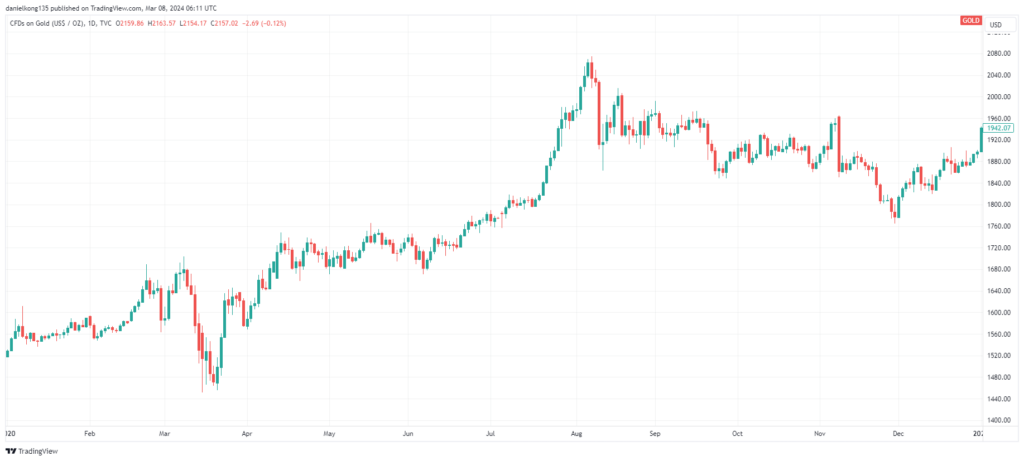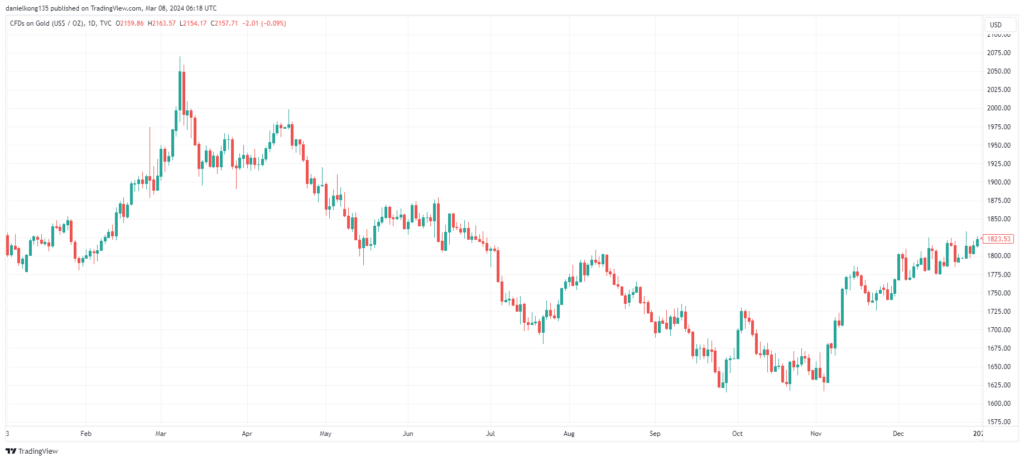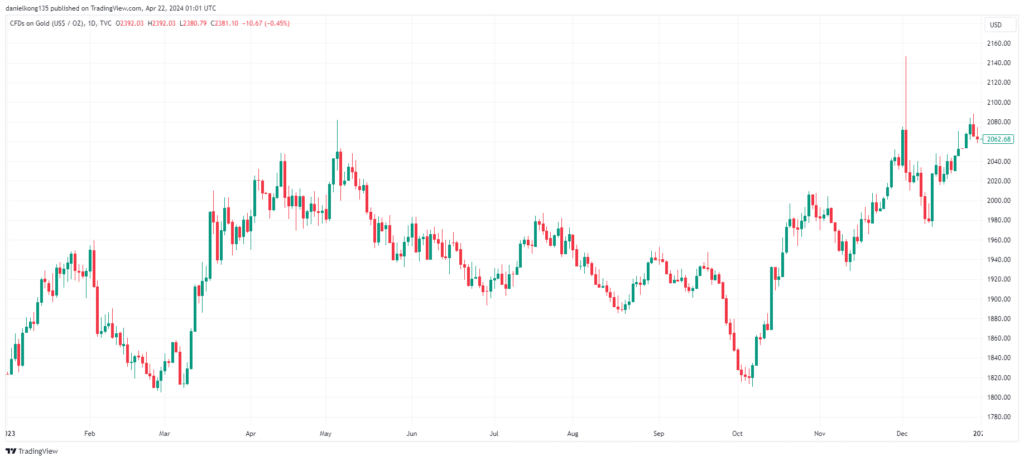For centuries, gold has been recognised as a safe-haven asset and store of value in times of stress and uncertainty. This precious metal has traditionally been valued by investors for its ability to provide financial security against unexpected economic shocks.
Notably, gold reached a new peak in value on 5 March 2024 driven by the continuation of geopolitical tensions in regions such as Ukraine and the Middle East, which led to increased investment in gold as central banks have continued purchasing it as a protective measure against inflation.
In 2024, gold has risen by approximately 17% and even reaching above $2,400 per ounce on 12 April [1,2].
Interest rates also play a significant role in determining the price of gold. These interest rates tend to increase during periods of high economic growth and inflation, significantly influencing the financial markets. Over the past year, central banks have initiated a series of aggressive interest rate hikes to control inflationary pressures. However, despite these measures, inflation has begun to stabilise, and economic activities have continued to show resilience.
This article aims to examine the intricate relationship between the prices of gold and interest rates, shedding light on the reasons behind gold’s price reactions to changes in interest rates, monetary policies, and the value of the dollar. Additionally, we will explore other factors that may have contributed to the recent significant rise in gold prices.
Key Points
- Gold has traditionally been a preferred investment choice during economic uncertainties, with gold price reaching a new peak driven by geopolitical tensions.
- Gold prices and interest rates have an inverse relationship, with real interest rates (adjusted for inflation) being a primary factor affecting gold’s value.
- Anticipation of interest rate cuts and global economic conditions can significantly influence gold’s appeal and investment strategies.
Understanding the Basics of Gold vs Interest Rates
Interest rates are widely considered to be a primary factor influencing gold prices, particularly the “real” interest rates, which are adjusted for inflation.
There is typically an inverse relationship between gold and real interest rates. This means that as interest rates and bond yields increase, the appeal of gold, which does not bear interest, decreases. Higher interest rates raise the opportunity cost of holding gold because it does not yield any income.
However, there are instances where this relationship does not hold.
For example, gold prices have shown resilience even when real rates rose due to concerns over economic growth or potential policy errors by the Federal Reserve. This indicates that factors other than interest rates can also impact gold prices. The strength and fluctuations of the US dollar, along with US monetary policy, also play significant roles in gold price movements.
In recent years, the purchasing of gold by central banks has increased as some countries seek to diversify their reserves into safe assets. These sanctions being imposed on foreign assets, similar to those enacted by the US and Europe against Russian resources, has prompted a reassessment of currency reserves strategies, affecting gold demand.
Historical Perspective
Historical analysis suggests that the relationship between gold and interest rates is often inverse, but the strength of this correlation may be overstated. For instance, during the 1970s, gold prices surged to new highs even amidst high and rising interest rates.
The Federal Reserve’s interest rate decisions significantly influence the gold market. Higher interest rates lead to increased borrowing costs, typically reducing gold demand and lowering its price. For example, the 2015 rate increase by the Federal Open Market Committee (FOMC), its first in years, resulted in a decline in gold prices.
Conversely, when rates were cut during the pandemic in 2020, gold enthusiasts pushed its price over $2,000 to a record $2,047 in August 2020 [3].

However, the commencement of the Fed’s rate hiking cycle in March 2022 saw a decrease in gold prices.

In 2023, gold prices remained relatively stable despite challenges from rising interest rates and a generally stronger dollar. Real yields, which consider inflation, rose from low levels, diminishing gold’s appeal due to its lack of yield. This situation led to significant outflows from exchange traded funds (ETFs) in the investment community.
Nevertheless, this reduced demand was more than compensated for by robust buying from central banks. In response to geopolitical tensions, central banks purchased a record amount of gold in the first three quarters of 2023, reflecting gold’s increased allure during times of uncertainty.

Curious about how gold prices have evolved over time? Dive deeper into our comprehensive article on the trend analysis of gold prices to broaden your macroeconomic understanding of gold and its price action.
Expectations of Gold going into 2024
At the end of 2023, market expectations for central bank policies underwent a significant adjustment. A decline in inflation and employment metrics led traders to revise their forecasts, moving away from anticipating further rate hikes and instead expecting rate cuts in the early part of 2024. These revised expectations of more lenient policies contributed to a weakening of the dollar, which in turn, made gold more appealing.
However, in recent weeks, the anticipation of early rate cuts has been tempered as market participants adjusted their outlooks due to better-than-expected performance of the US economy. Persistent inflation, particularly driven by a robust labour market, has kept services inflation high. This situation suggests that interest rates might need to stay elevated for an extended period.
Learn all about the interest rate and impending rate cuts to understand how you can navigate through the year 2024 better.
Future Outlook for Gold
The upcoming year presents both challenges and opportunities for those involved in gold trading and investment. The policies of the US Federal Reserve will be a crucial factor, as they will determine the direction of interest rates—whether they will remain high or be reduced—which in turn affects the US dollar and gold prices.
Current money market forecasts suggest little likelihood of an interest rate decrease before June, with expectations set for three 25 basis point cuts throughout the remainder of the year.
The US economy’s recent performance, showing 3.3% growth in the last quarter of 2023 and continuing this positive trend into the new year, coupled with a complex inflation scenario, places the Federal Reserve in a cautious stance [4].
This environment typically does not favour gold investment. However, investors tend to anticipate future economic conditions, and any signs of economic slowdown could lead to a rise in gold prices as the market begins to anticipate interest rate cuts once more.
The investment strategies and positions of speculators and significant investors also play a critical role in determining gold’s future price direction. At the beginning of the year, net long positions in gold decreased, with further reductions observed in February as the prospects for interest rate cuts diminished and the dollar grew stronger. Nevertheless, net inflows are expected to increase if interest rates start to decrease.
According to a 2023 survey by the World Gold Council, 24% of central banks worldwide plan to increase their gold reserves in the next year, potentially driving a long-term increase in gold prices [5]. The motivations behind this include diversifying reserves and addressing geopolitical uncertainties.
Additionally, physical demand for gold in China has exceeded expectations following the Lunar New Year holidays, indicating strong ongoing interest. Read our article covering gold relation with Lunar New Year to help you understand this relation better.
In India, consumer adaptation to higher gold prices, along with a positive economic forecast for 2024, suggests promising prospects for gold purchases.
Conclusion
Gold has consistently attracted investors as a reliable store of value and a protective measure against economic turbulence and market uncertainties. Recent geopolitical events have contributed to heightened global instability, a trend that could persist in the face of the upcoming US election. Moreover, the threat of a recession might escalate if consumer spending declines due to the strain of high interest rates and rising costs.
These dynamics play a critical role in shaping central banks’ decisions on monetary policies and interest rates, which in turn influence the pricing and demand for gold. Any delays in reducing inflation could result in interest rates remaining elevated longer than current market predictions anticipate. However, gold has recently reached new peaks due to various contributing factors.
Thus, closely monitoring economic indicators becomes essential to understand the intricate relationship between gold prices and interest rates effectively.
Discover everything you need to know about gold by reading our comprehensive gold guide. Alternatively, if you’re ready to trade gold, you can open a live account with Vantage today and gain access to our cutting-edge trading platform and resources to trade gold CFDs.
References
- “Gold surges as Middle East tensions spur safe-haven rush – Reuters” https://www.reuters.com/markets/commodities/gold-prices-hit-record-highs-safe-haven-demand-2024-04-12/ Accessed 21 April 2024
- “Gold price forecast for spring 2024: Here’s what experts predict – CBS News” https://www.cbsnews.com/news/gold-price-forecast-for-spring-2024-heres-what-experts-predict/ Accessed 21 April 2024
- “After Covid-19, just how high will prices go in the 2020 gold rush? – The Guardian” https://www.theguardian.com/business/2020/aug/05/after-covid-19-just-how-high-will-prices-go-in-the-2020-gold-rush Accessed 8 March 2024
- “The U.S. economy grew at blistering 3.3% pace in Q4 while inflation pulled back – CNBC” https://www.cnbc.com/2024/01/25/gdp-q4-2023-the-us-economy-grew-at-a-3point3percent-pace-in-the-fourth-quarter.html Accessed 8 March 2024
- “2023 Central Bank Gold Reserves Survey – World Gold Council” https://www.gold.org/goldhub/data/2023-central-bank-gold-reserves-survey Accessed 8 March 2024



